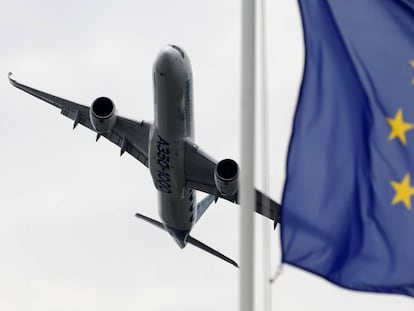Fear of flying? Climate change also intensifies turbulence in the air
A study shows that the total annual duration of severe turbulence increased by 55% over the last 40 years and could triple by the end of the century

Place your handheld luggage under the seats in front of you, fasten your seat belts and put all electronic devices on airplane mode. This is how many summer vacations begin. The plane takes off with passengers who have fallen asleep within a second of sitting down and others who are clinging tightly to the armrests to calm their nerves and, after a few minutes, everything seems to go smoothly. People get up and the flight attendants start selling all kinds of food and items to try to make the trip feel less long. Then the pilot turns the seatbelt sign back on and asks everyone to return to their seats because the plane is going through turbulence. These episodes — which, although they can be annoying, barely pose any danger to passenger safety — have intensified in recent decades. The cause? Once again, it is about climate change.
“We’re noticing it a lot since we’ve been flying again after the pandemic. In the middle of summer, it is very common to have severe turbulence after three o’clock in the afternoon, when temperatures are at their highest,” acknowledges Rubén González, a professional pilot and flight instructor at Aeroclub Barcelona Sabadell. According to an analysis by the University of Reading in the United Kingdom, clear-air turbulence, which occurs most frequently at high altitude, could triple by the end of the century. After analyzing air traffic over the North Atlantic, one of the world’s busiest routes, the study shows that the total annual duration of severe turbulence — the third strongest type on a scale of light, moderate, severe, and extreme — increased by 55% over the past 40 years, from 17.7 hours in 1979 to 24.7 hours in 2020.
Research suggests that in the coming years the number of turbulence-related incidents could increase, leading to more injuries to passengers and crew who, if they are not seated when the plane is caught in unforeseen turbulence and are not wearing seat belts, can be thrown into the ceiling. This is not to say that fatal accidents — a rarity in the case of air travel — will increase. “Aircraft are designed to withstand severe conditions; the safety margins are very wide. Structural damage from turbulence is still rare,” says Gonzalez, who has been flying for a decade.
However, increased turbulence also comes at an economic cost to airlines. “Increased turbulence costs the industry between $150 million and $500 million [€130 million and €450 million] a year in the U.S. alone. Every minute spent traveling through turbulence increases the wear and tear on the aircraft, as well as the risk of injury to those inside,” warns researcher Mark Prosser, an atmospheric scientist and co-author of the study, who acknowledges that turbulence will become ever more frequent as global temperatures continue to rise.
A consequence of rising temperatures
To understand the role of climate change, it is first necessary to explain when and why these episodes occur. Turbulence is an unstable movement of air caused by changes in wind direction and speed, such as with storms, or weather fronts (both warm and cold). However, turbulence is not always caused by bad weather, but can also occur when the sky is calm and cloudless, as in the case of clear-air turbulence. “That is the turbulence experienced by aircraft when they are in cruise phase in the middle of the Atlantic. It is invisible to the human eye, and it also escapes radar,” explains aeronautical meteorologist Benito Fuentes.
During these types of routes, pilots take advantage of jet streams — strong, intense airflows located at the boundary between the troposphere and the stratosphere — to travel faster and reduce fuel consumption. This allows for shorter transatlantic flights when flying from America to Europe. However, it is precisely in the proximity of these currents that there is a strong change in wind direction, from vertical to horizontal flow, and this causes turbulence.
“The atmosphere works like a pot full of water. If you are not in a hurry and warm it up slowly, it will heat up without creating any problems. But if you put it on full power, it starts to bubble and boil over. Like the pot, the atmosphere also heats up from below, and the higher the temperature, the greater the changes in currents and the greater the likelihood of turbulence,” says César Mösso, professor of environmental engineering at the Polytechnic University of Catalonia.
Shaking aircraft and bumpier flights are not the only disadvantages of climate change when it comes to flying. High temperatures can also influence the two most delicate phases of every flight: take-off and landing. The warmer it is, the lower the air density, and when the air is less dense, airplanes need more time to take off. In other words, it means they need a longer runway — and not all airports meet these requirements — and more fuel, which in turn means more pollution.
The problem does not seem to have a solution at the moment. Commercial flights, which are responsible for a good part of CO² emissions, have become more dangerous because of global warming. But, in order to continue to meet demand, they would have to increase their carbon footprint to cope with the difficulties of rising temperatures, especially during the summer. “If turbulence becomes too bumpy in the future, aircraft could fly farther away from the jet stream, but this would increase travel time, fuel use, and climate-warming emissions. Basically, it’s a vicious circle,” Prosser concludes.
Sign up for our weekly newsletter to get more English-language news coverage from EL PAÍS USA Edition
Tu suscripción se está usando en otro dispositivo
¿Quieres añadir otro usuario a tu suscripción?
Si continúas leyendo en este dispositivo, no se podrá leer en el otro.
FlechaTu suscripción se está usando en otro dispositivo y solo puedes acceder a EL PAÍS desde un dispositivo a la vez.
Si quieres compartir tu cuenta, cambia tu suscripción a la modalidad Premium, así podrás añadir otro usuario. Cada uno accederá con su propia cuenta de email, lo que os permitirá personalizar vuestra experiencia en EL PAÍS.
¿Tienes una suscripción de empresa? Accede aquí para contratar más cuentas.
En el caso de no saber quién está usando tu cuenta, te recomendamos cambiar tu contraseña aquí.
Si decides continuar compartiendo tu cuenta, este mensaje se mostrará en tu dispositivo y en el de la otra persona que está usando tu cuenta de forma indefinida, afectando a tu experiencia de lectura. Puedes consultar aquí los términos y condiciones de la suscripción digital.
More information
Archived In
Últimas noticias
NASA discovers Titan doesn’t have an ocean, but a ‘slushy ice layer’ that increases possibility of life
Innocence lost in the forest of the child soldiers: ‘Each leader of the armed group had his girls’
‘Fallout’ or how the world’s largest company turned an anti-capitalist apocalyptic Western into a phenomenon
From inflation to defending migrants: Eileen Higgins and Zohran Mamdani inaugurate the new Democratic resistance against Trump
Most viewed
- ‘El Limones’ and the growing union disguise of Mexican organized crime
- Christian Louboutin: ‘Young people don’t want to be like their parents. And if their parents wear sneakers, they’re going to look for something else’
- The low-cost creative revolution: How technology is making art accessible to everyone
- ‘We are dying’: Cuba sinks into a health crisis amid medicine shortages and misdiagnosis
- Liset Menéndez de la Prida, neuroscientist: ‘It’s not normal to constantly seek pleasure; it’s important to be bored, to be calm’











































